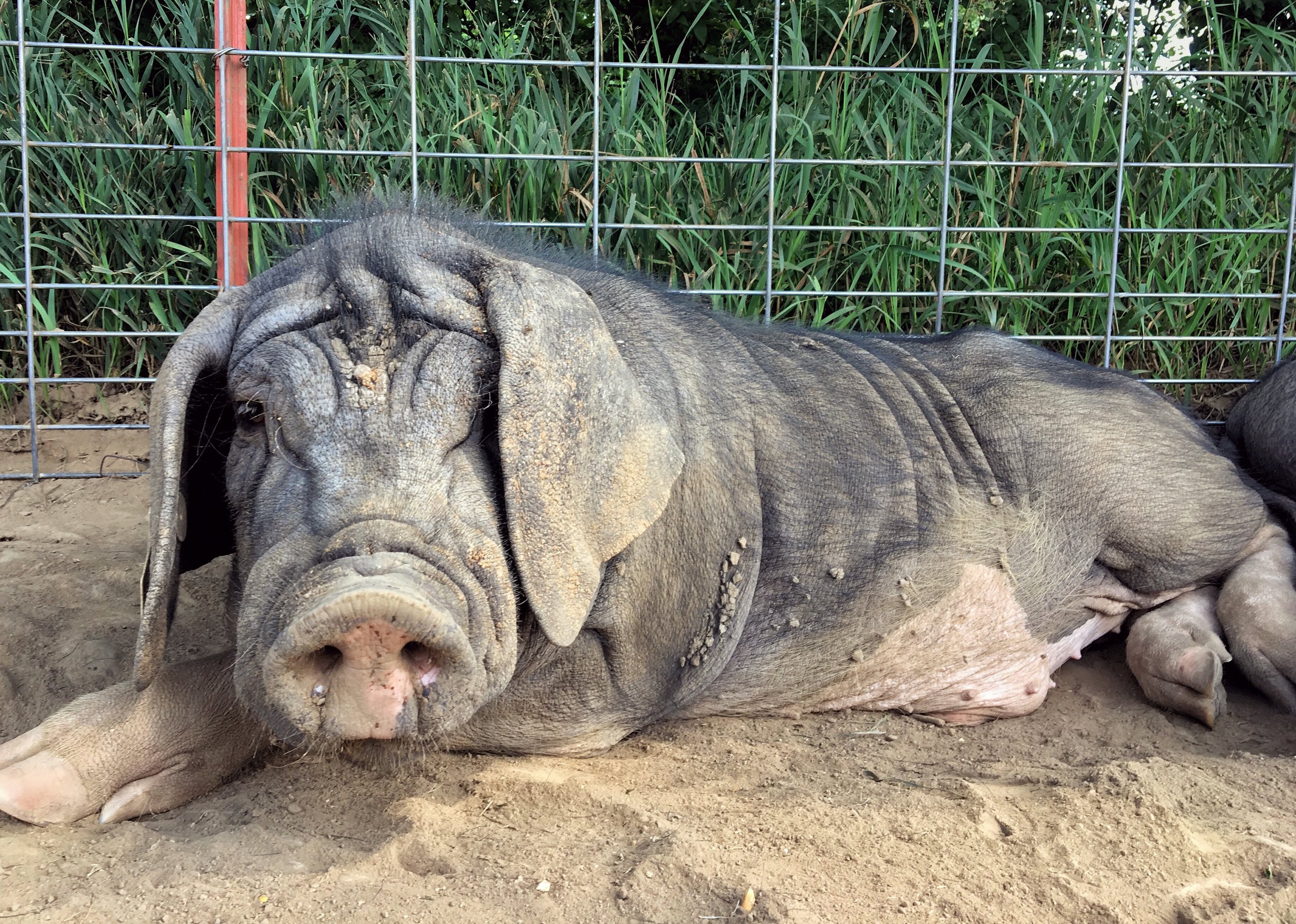Chauncey.
HISTORY
The Meishan is one of, if not the oldest breed of swine in the world and have been selectively bred in China for over 5000 years. Meishans have been bred for prolificacy and to thrive on rougher diets with more fiber than other pigs. Taihu pigs are prized in China and Japan for their succulent marbled meat and superior lard and fat quality.
The breed was introduced to the United States in 1989 by the USDA, Iowa State University, and University of Illinois. 99 Meishans were imported after years of negotiations with China and were equally divided (by sex and genetic profile) between the three research facilities.
After 25 years the research ended and the Meishans were dispersed with no effort to preserve the breed. Their slow growth and medium size made them unappealing to the commercial industry at the time. No records were kept and many of the pigs were inbred or crossbred. Rico Silvera of God’s Blessing Farm worked endlessly driving thousands of miles to obtain the last verifiable pure Meishans from all 3 facilities. In 2018 we purchased our herd from Rico which is now the 2nd most genetically diverse herd outside of China.
TRAITS
Prolificity
Meishans are considered perhaps the most prolific breed of pig in the world. They reach puberty at 2.5-3 months of age and have high embryo survival rates. It is expected for a sow to farrow 13-15, but litters of 16 or more aren’t uncommon. A littler of 28 was born in the USDA research facility. So far, 18 is our largest litter.
meat & fat quality
The breed produces a dark red, steaky meat with both inter-muscular and intra-muscular fat. The fat and lard renders at a lower temperature making it melt in your mouth. Due to their diet the meat and fat are incredibly nourishing and healthy. Pork fat is #8 on the BBC’s list of the world’s top 100 most nutritious foods.
diet
Meishans have much larger stomachs than other breeds of swine. This allows them to consume more fiber in their diet than other pigs. While higher levels of fiber does impede their ability to absorb protein and amino acids they digest the carbohydrates much more efficiently than other breeds. This makes them slow growing but overall more economical to raise than many heritage breeds.
disease & parasite resistance
Like other heritage breeds, Meishans have not been given dewormers and antibiotics, allowing them a natural disease and parasite resistance that breeds suited for a commercial setting would not have. They've been bred for over 5000 years to thrive without pharmaceutical intervention making immunity to ailments and parasites inherent.
docility
An obvious trait of the breed is their docility. They have been bred to be extremely quiet, docile, and sedentary. This allows us to work with them closely and comfortably and spend time inside the farrowing pens with the sows and piglets from the time they are born. Being able to work around and easily manage them with little stress is very important to us and makes for less stressed, happier animals and farmers.
Safety is an important consideration for anyone looking to get into raising their own livestock, and many breeds can be aggressive and dangerous. We believe this makes the Meishan a very ideal breed for homesteaders, new farmers, or just about anyone.
Genetic Diversity
The trait that most appealed to us with the Meishans was their diversity. Many rare breeds have very limited genetic diversity. Because they were held in different facilities there are now distinct genetic lines without a common ancestor for 30 years. In the research facilities, they were insured not to be inbred but were otherwise bred randomly. This destabilized and randomized their genetics in a way that is enormously opportunistic. While being incredibly rare Meishans have an impressive range of genetic variation. This makes it easier for a breeder to select and stabilize the traits they want without having to undo several generations of bad breeding. Coupled with their potential for low feed cost and large litters Meishans make it economical for small farmers to have their own breeding programs tailoring the genetics of their herd to thrive under their particular farm management.
Citations
Rydhmer, Lotta, and Laurianne Canario. “Chapter 11 - Behavioral Genetics in Pigs and Relations to Welfare.” Genetics and the Behavior of Domestic Animals, Second Edition ed., Elsevier Inc. Chapters, 2013, pp. 397–434.
“The Meishan Pig.” The Livestock Conservancy , livestockconservancy.org/index.php/heritage/internal/meishan.
